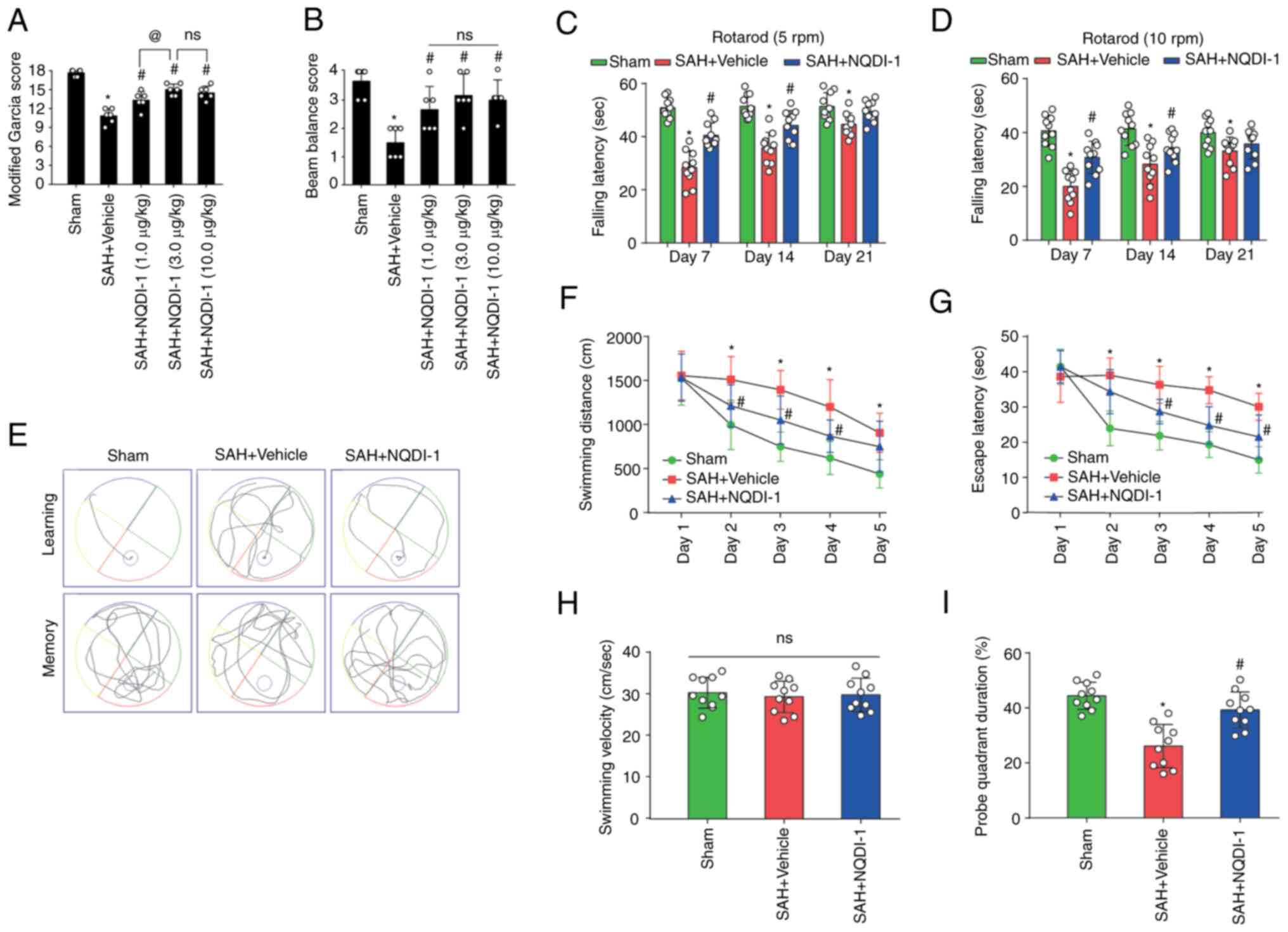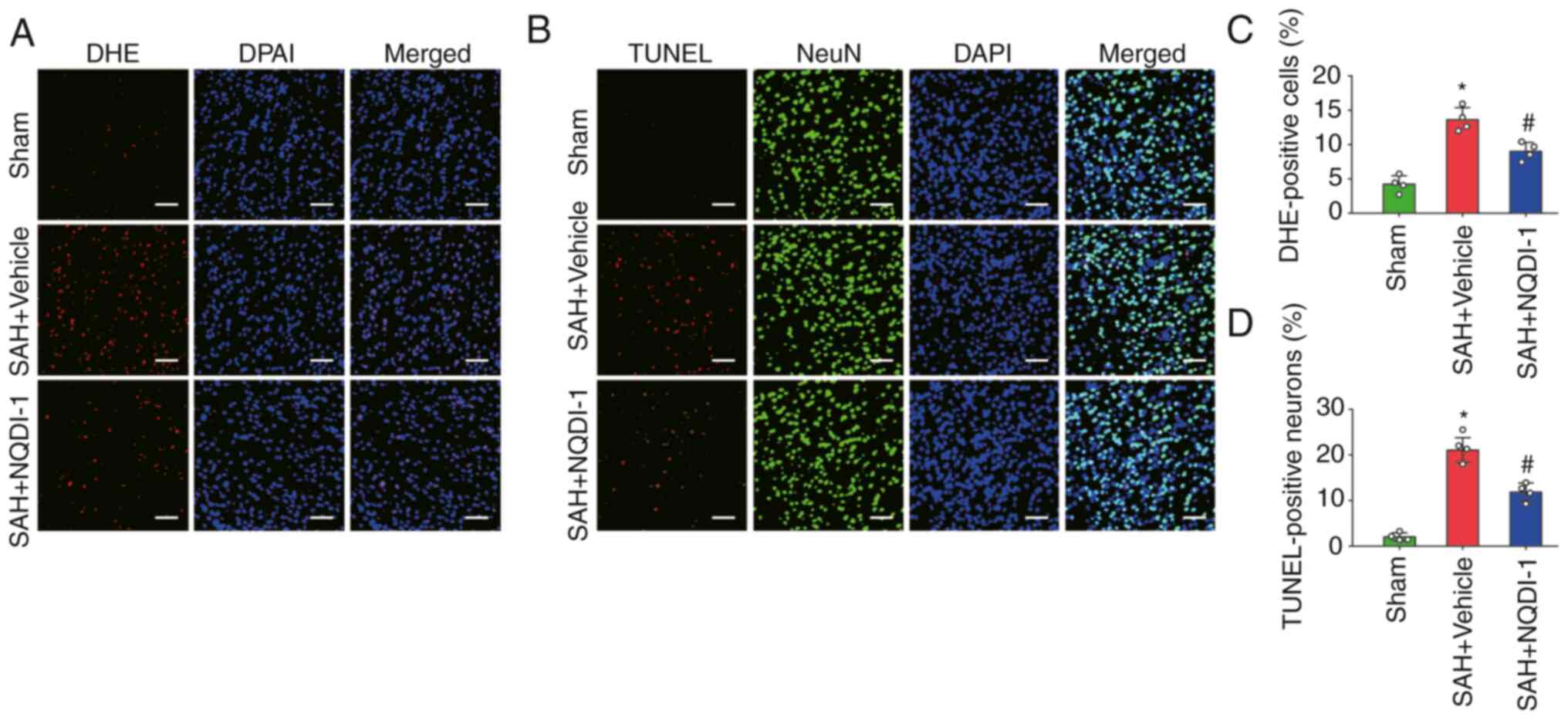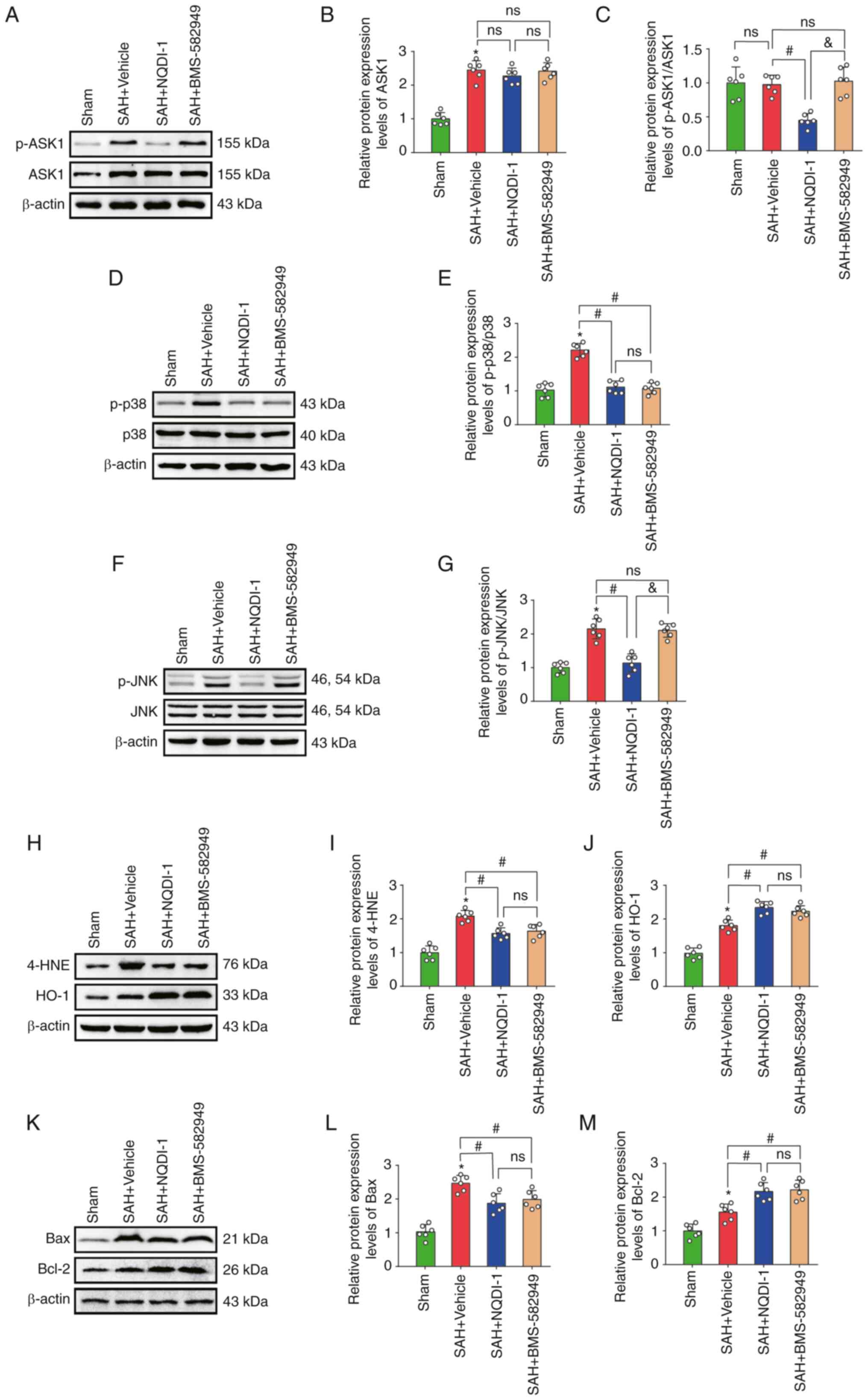|
1
|
Lawton MT and Vates GE: Subarachnoid
Hemorrhage. N Engl J Med. 377:257–266. 2017. View Article : Google Scholar : PubMed/NCBI
|
|
2
|
GBD 2019 Stroke Collaborators, . Global,
regional, and national burden of stroke and its risk factors,
1990–2019: A systematic analysis for the Global Burden of Disease
Study 2019. Lancet Neurol. 20:795–820. 2021. View Article : Google Scholar : PubMed/NCBI
|
|
3
|
Osgood ML: Aneurysmal subarachnoid
hemorrhage: Review of the pathophysiology and management
strategies. Curr Neurol Neurosci Rep. 21:502021. View Article : Google Scholar : PubMed/NCBI
|
|
4
|
Topkoru B, Egemen E, Solaroglu I and Zhang
JH: Early brain injury or vasospasm? An overview of common
mechanisms. Curr Drug Targets. 18:1424–1429. 2017. View Article : Google Scholar : PubMed/NCBI
|
|
5
|
Merlini E, Coleman MP and Loreto A:
Mitochondrial dysfunction as a trigger of programmed axon death.
Trends Neurosci. 45:53–63. 2022. View Article : Google Scholar : PubMed/NCBI
|
|
6
|
Kowalczyk P, Sulejczak D, Kleczkowska P,
Bukowska-Ośko I, Kucia M, Popiel M, Wietrak E, Kramkowski K,
Wrzosek K and Kaczyńska K: Mitochondrial oxidative stress-A
causative factor and therapeutic target in many diseases. Int J Mol
Sci. 22:133842021. View Article : Google Scholar : PubMed/NCBI
|
|
7
|
Matsushita M, Nakamura T, Moriizumi H,
Miki H and Takekawa M: Stress-responsive MTK1 SAPKKK serves as a
redox sensor that mediates delayed and sustained activation of
SAPKs by oxidative stress. Sci Adv. 6:eaay97782020. View Article : Google Scholar : PubMed/NCBI
|
|
8
|
Gao Y, Yan Y, Fang Q, Zhang N, Kumar G,
Zhang J, Song LJ, Yu J, Zhao L, Zhang HT and Ma CG: The Rho kinase
inhibitor fasudil attenuates Aβ1-42-induced apoptosis
via the ASK1/JNK signal pathway in primary cultures of hippocampal
neurons. Metab Brain Dis. 34:1787–1801. 2019. View Article : Google Scholar : PubMed/NCBI
|
|
9
|
Volynets GP, Chekanov MO, Synyugin AR,
Golub AG, Kukharenko OP, Bdzhola VG and Yarmoluk SM: Identification
of 3H-naphtho[1,2,3-de]quinoline-2,7-diones as inhibitors of
apoptosis signal-regulating kinase 1 (ASK1). J Med Chem.
54:2680–2686. 2011. View Article : Google Scholar : PubMed/NCBI
|
|
10
|
Zhang QS, Kurpad DS, Mahoney MG, Steinbeck
MJ and Freeman TA: Inhibition of apoptosis signal-regulating kinase
1 alters the wound epidermis and enhances auricular cartilage
regeneration. PLoS One. 12:e01858032017. View Article : Google Scholar : PubMed/NCBI
|
|
11
|
Hao H, Li S, Tang H, Liu B, Cai Y, Shi C
and Xiao X: NQDI-1, an inhibitor of ASK1 attenuates acute perinatal
hypoxic-ischemic cerebral injury by modulating cell death. Mol Med
Rep. 13:4585–4592. 2016. View Article : Google Scholar : PubMed/NCBI
|
|
12
|
Chen S, Zuo Y, Huang L, Sherchan P, Zhang
J, Yu Z, Peng J, Zhang J, Zhao L, Doycheva D, et al: The MC
receptor agonist RO27-3225 inhibits NLRP1-dependent neuronal
pyroptosis via the ASK1/JNK/p38 MAPK pathway in a mouse model of
intracerebral haemorrhage. Br J Pharmacol. 176:1341–1356. 2019.
View Article : Google Scholar : PubMed/NCBI
|
|
13
|
Du X, Liu H, Liu X, Chen X, Yuan L, Ma Y,
Huang H, Wang Y, Wang R, Zhang S, et al: Microcystin-LR induces
ovarian injury and apoptosis in mice via activating apoptosis
signal-regulating kinase 1-mediated P38/JNK pathway. Ecotoxicol
Environ Saf. 213:1120662021. View Article : Google Scholar : PubMed/NCBI
|
|
14
|
Chang CY, Li JR, Wu CC, Wang JD, Liao SL,
Chen WY, Wang WY and Chen CJ: Endoplasmic reticulum stress
contributes to indomethacin-induced glioma apoptosis. Int J Mol
Sci. 21:5572020. View Article : Google Scholar : PubMed/NCBI
|
|
15
|
Win S, Than TA, Zhang J, Oo C, Min RWM and
Kaplowitz N: New insights into the role and mechanism of
c-Jun-N-terminal kinase signaling in the pathobiology of liver
diseases. Hepatology. 67:2013–2024. 2018. View Article : Google Scholar : PubMed/NCBI
|
|
16
|
Percie du Sert N, Ahluwalia A, Alam S,
Avey MT, Baker M, Browne WJ, Clark A, Cuthill IC, Dirnagl U,
Emerson M, et al: Reporting animal research: Explanation and
elaboration for the ARRIVE guidelines 2.0. PLoS Biol.
18:e30004112020. View Article : Google Scholar : PubMed/NCBI
|
|
17
|
McPherson C: Regulation of animal care and
research? NIH's opinion. J Anim Sci. 51:492–496. 1980. View Article : Google Scholar : PubMed/NCBI
|
|
18
|
Boivin GP, Hickman DL, Creamer-Hente MA,
Pritchett-Corning KR and Bratcher NA: Review of CO2 as a
euthanasia agent for laboratory rats and mice. J Am Assoc Lab Anim
Sci. 56:491–499. 2017.PubMed/NCBI
|
|
19
|
Luo K, Wang Z, Zhuang K, Yuan S, Liu F and
Liu A: Suberoylanilide hydroxamic acid suppresses axonal damage and
neurological dysfunction after subarachnoid hemorrhage via the
HDAC1/HSP70/TDP-43 axis. Exp Mol Med. 54:1423–1433. 2022.
View Article : Google Scholar : PubMed/NCBI
|
|
20
|
Xie Z, Enkhjargal B, Nathanael M, Wu L,
Zhu Q, Zhang T, Tang J and Zhang JH: viaExendin-4 preserves
blood-brain barrier integrity glucagon-like peptide 1
receptor/activated protein kinase-dependent nuclear Factor-Kappa
B/Matrix Metalloproteinase-9 inhibition after subarachnoid
hemorrhage in rat. Front Mol Neurosci. 14:7507262021. View Article : Google Scholar : PubMed/NCBI
|
|
21
|
Craft TK and DeVries AC: Role of IL-1 in
poststroke depressive-like behavior in mice. Biol Psychiatry.
60:812–818. 2006. View Article : Google Scholar : PubMed/NCBI
|
|
22
|
Xie Z, Enkhjargal B, Wu L, Zhou K, Sun C,
Hu X, Gospodarev V, Tang J, You C and Zhang JH: Exendin-4
attenuates neuronal death via GLP-1R/PI3K/Akt pathway in early
brain injury after subarachnoid hemorrhage in rats.
Neuropharmacology. 128:142–151. 2018. View Article : Google Scholar : PubMed/NCBI
|
|
23
|
Liu C, Lin J, Wrobleski ST, Lin S, Hynes
J, Wu H, Dyckman AJ, Li T, Wityak J, Gillooly KM, et al: Discovery
of
4-(5-(cyclopropylcarbamoyl)-2-methylphenylamino)-5-methyl-N-propylpyrrolo[1,2-f][1,2,4]triazine-6-carboxamide
(BMS-582949), a clinical p38α MAP kinase inhibitor for the
treatment of inflammatory diseases. J Med Chem. 53:6629–6639. 2010.
View Article : Google Scholar : PubMed/NCBI
|
|
24
|
Bennett BL, Sasaki DT, Murray BW, O'Leary
EC, Sakata ST, Xu W, Leisten JC, Motiwala A, Pierce S, Satoh Y, et
al: SP600125, an anthrapyrazolone inhibitor of Jun N-terminal
kinase. Proc Natl Acad Sci USA. 98:13681–13686. 2001. View Article : Google Scholar : PubMed/NCBI
|
|
25
|
Dai J, Xu S, Okada T, Liu Y, Zuo G, Tang
J, Zhang JH and Shi H: T0901317, an agonist of liver X receptors,
attenuates neuronal apoptosis in early brain injury after
subarachnoid hemorrhage in rats via liver X receptors/interferon
regulatory factor/P53 upregulated modulator of
apoptosis/dynamin-1-like protein pathway. Oxid Med Cell Longev.
2021:88491312021. View Article : Google Scholar : PubMed/NCBI
|
|
26
|
Xiao ZP, Lv T, Hou PP, Manaenko A, Liu Y,
Jin Y, Gao L, Jia F, Tian Y, Li P, et al: Sirtuin 5-Mediated lysine
desuccinylation protects mitochondrial metabolism following
subarachnoid hemorrhage in mice. Stroke. 52:4043–4053. 2021.
View Article : Google Scholar : PubMed/NCBI
|
|
27
|
Xu W, Yan J, Ocak U, Lenahan C, Shao A,
Tang J, Zhang J and Zhang JH: viaMelanocortin 1 receptor attenuates
early brain injury following subarachnoid hemorrhage by controlling
mitochondrial metabolism AMPK/SIRT1/PGC-1α pathway in rats.
Theranostics. 11:522–539. 2021. View Article : Google Scholar : PubMed/NCBI
|
|
28
|
Mo J, Enkhjargal B, Travis ZD, Zhou K, Wu
P, Zhang G, Zhu Q, Zhang T, Peng J, Xu W, et al: AVE 0991
attenuates oxidative stress and neuronal apoptosis via
Mas/PKA/CREB/UCP-2 pathway after subarachnoid hemorrhage in rats.
Redox Biol. 20:75–86. 2019. View Article : Google Scholar : PubMed/NCBI
|
|
29
|
He Y, Zheng Z, Liu C, Li W, Zhao L, Nie G
and Li H: viaInhibiting DNA methylation alleviates
cisplatin-induced hearing loss by decreasing oxidative
stress-induced mitochondria-dependent apoptosis the LRP1-PI3K/AKT
pathway. Acta Pharm Sin B. 12:1305–1321. 2022. View Article : Google Scholar : PubMed/NCBI
|
|
30
|
van Lieshout JH, Marbacher S, Muhammad S,
Boogaarts HD, Bartels RHMA, Dibué M, Steiger HJ, Hänggi D and Kamp
MA: Proposed definition of experimental secondary ischemia for
mouse subarachnoid hemorrhage. Transl Stroke Res. 11:1165–1170.
2020. View Article : Google Scholar : PubMed/NCBI
|
|
31
|
Ogier JM, Nayagam BA and Lockhart PJ: ASK1
inhibition: A therapeutic strategy with multi-system benefits. J
Mol Med (Berl). 98:335–348. 2020. View Article : Google Scholar : PubMed/NCBI
|
|
32
|
Zhang XS, Lu Y, Li W, Tao T, Peng L, Wang
WH, Gao S, Liu C, Zhuang Z, Xia DY, et al: Astaxanthin ameliorates
oxidative stress and neuronal apoptosis via
SIRT1/NRF2/Prx2/ASK1/p38 after traumatic brain injury in mice. Br J
Pharmacol. 178:1114–1132. 2021. View Article : Google Scholar : PubMed/NCBI
|
|
33
|
Chen S, Yu Q, Song Y, Cui Z, Li M, Mei C,
Cui H, Cao S and Zhu C: Inhibition of macrophage migration
inhibitory factor (MIF) suppresses apoptosis signal-regulating
kinase 1 to protect against liver ischemia/reperfusion injury.
Front Pharmacol. 13:9519062022. View Article : Google Scholar : PubMed/NCBI
|
|
34
|
Xie X, Yuan C, Yin L, Zhu Q, Ma N, Chen W,
Ding Y, Xiao W, Gong W, Lu G, et al: NQDI-1 protects against acinar
cell necrosis in three experimental mouse models of acute
pancreatitis. Biochem Biophys Res Commun. 520:211–217. 2019.
View Article : Google Scholar : PubMed/NCBI
|
|
35
|
Cheon SY, Cho KJ, Kim SY, Kam EH, Lee JE
and Koo BN: Blockade of apoptosis signal-regulating kinase 1
attenuates matrix metalloproteinase 9 activity in brain endothelial
cells and the subsequent apoptosis in neurons after ischemic
injury. Front Cell Neurosci. 10:2132016. View Article : Google Scholar : PubMed/NCBI
|
|
36
|
Zhu Q, Enkhjargal B, Huang L, Zhang T, Sun
C, Xie Z, Wu P, Mo J, Tang J, Xie Z and Zhang JH: Aggf1 attenuates
neuroinflammation and BBB disruption via PI3K/Akt/NF-κB pathway
after subarachnoid hemorrhage in rats. J Neuroinflammation.
15:1782018. View Article : Google Scholar : PubMed/NCBI
|
|
37
|
Wu Y, Liu Y, Zhou C, Wu Y, Sun J, Gao X
and Huang Y: Biological effects and mechanisms of caspases in early
brain injury after subarachnoid hemorrhage. Oxid Med Cell Longev.
2022:33456372022. View Article : Google Scholar : PubMed/NCBI
|
|
38
|
Checa J and Aran JM: Reactive oxygen
species: Drivers of Physiological and pathological processes. J
Inflamm Res. 13:1057–1073. 2020. View Article : Google Scholar : PubMed/NCBI
|
|
39
|
Zhang Z, Zhang A, Liu Y, Hu X, Fang Y,
Wang X, Luo Y, Lenahan C and Chen S: New Mechanisms and Targets of
Subarachnoid Hemorrhage: A Focus on Mitochondria. Curr
Neuropharmacol. 20:1278–1296. 2022. View Article : Google Scholar : PubMed/NCBI
|
|
40
|
Liu B, Tian Y, Li Y, Wu P, Zhang Y, Zheng
J and Shi H: ACEA Attenuates Oxidative Stress by Promoting
Mitophagy via CB1R/Nrf1/PINK1 Pathway after Subarachnoid Hemorrhage
in Rats. Oxid Med Cell Longev. 2022:10242792022. View Article : Google Scholar : PubMed/NCBI
|
|
41
|
Iroegbu JD, Ijomone OK, Femi-Akinlosotu OM
and Ijomone OM: ERK/MAPK signalling in the developing brain:
Perturbations and consequences. Neurosci Biobehav Rev. 131:792–805.
2021. View Article : Google Scholar : PubMed/NCBI
|
|
42
|
Anjum J, Mitra S, Das R, Alam R, Mojumder
A, Emran TB, Islam F, Rauf A, Hossain MJ, Aljohani ASM, et al: A
renewed concept on the MAPK signaling pathway in cancers:
Polyphenols as a choice of therapeutics. Pharmacol Res.
184:1063982022. View Article : Google Scholar : PubMed/NCBI
|
|
43
|
Wei YX, Zhang DD, Gao YY, Hang CH and Shi
JX: Inhibition of the myeloid differentiation primary response
protein 88 reducres neuron injury in the early stages of
subarachnoid hemorrhage in an in vitro experimental model. J
Physiol Pharmacol. 73:2022.PubMed/NCBI
|

















